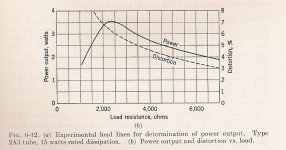Some newb questions here
1) For a given power output, is there any benefit to using larger output tubes vs smaller output tubes? e.g. if I wanted 6V6-level output, is there any benefit to running 6L6-sized tubes over 6V6-sized tubes? (of course I understand that individual tube type choices will also make a large difference).
2) Same question for OTs. For moderately priced OTs, is there a benefit to using larger-than-necessary transformers?
3) Finally, if I just want to slap together a simple amp (audio, not guitar) and I don't have suitable transformers, but have transformers of both higher and lower Z than the tube needs, is there a general consensus as to which choice (higher or lower) will sound better? e.g. if I have tubes that want 6.5k loads, but only have 5k and 8k transformers. Until the right ones come in, of course. 🙂
Many thanks for any advice!
1) For a given power output, is there any benefit to using larger output tubes vs smaller output tubes? e.g. if I wanted 6V6-level output, is there any benefit to running 6L6-sized tubes over 6V6-sized tubes? (of course I understand that individual tube type choices will also make a large difference).
2) Same question for OTs. For moderately priced OTs, is there a benefit to using larger-than-necessary transformers?
3) Finally, if I just want to slap together a simple amp (audio, not guitar) and I don't have suitable transformers, but have transformers of both higher and lower Z than the tube needs, is there a general consensus as to which choice (higher or lower) will sound better? e.g. if I have tubes that want 6.5k loads, but only have 5k and 8k transformers. Until the right ones come in, of course. 🙂
Many thanks for any advice!
Using a 6L6 in a 6V6 circuit is fine. The tube will last a lot longer but it uses more power to the heater.
Using larger OPTs is ok and will generally give better LF response.
Higher Z will give less power and less distortion, lower Z will do the opposite in most cases.
Personally, if I had tubes that wanted 6k5 and had 5k or 8k, I'd use 5k. You might also run 8k and raise the B+ voltage to obtain the power 🙂
Using larger OPTs is ok and will generally give better LF response.
Higher Z will give less power and less distortion, lower Z will do the opposite in most cases.
Personally, if I had tubes that wanted 6k5 and had 5k or 8k, I'd use 5k. You might also run 8k and raise the B+ voltage to obtain the power 🙂
Thanks for your comments. In general would larger tubes run at lower power have less distortion than smaller tubes run at the same power (for the same B+)?Using a 6L6 in a 6V6 circuit is fine. The tube will last a lot longer but it uses more power to the heater.
Using larger OPTs is ok and will generally give better LF response.
Higher Z will give less power and less distortion, lower Z will do the opposite in most cases.
Personally, if I had tubes that wanted 6k5 and had 5k or 8k, I'd use 5k. You might also run 8k and raise the B+ voltage to obtain the power 🙂
Not necessarily, no... Sometimes you get more distortion running the tubes cold. Usually a good design and some gNFB makes the difference negligible.
Thanks, I thought that might be the case.Not necessarily, no... Sometimes you get more distortion running the tubes cold. Usually a good design and some gNFB makes the difference negligible.
Choice of the OPT Impedance depends on whether you are running in pentode or triode mode.
That applies in both SE & PP. Triodes are relatively tolerant to load impedance, pentodes are not.
For a triode, theoretical max power occurs when Rl = 2rp. But in practical circuits max power is more likely to be when Rl ~ 2.5 rp.
So triodes in typical circuits are relatively easy to match. A Load mpedance greater than 3rp is OK for SE,
For common triodes in typical circuits refer to the graph shewing Power & Distortion vs Load Impedance.
The graph is typical of all triodes & triode connected pentodes.
Pentodes require that the load line go up into the knee of the plate curves. So a good match is
necessary for optimum performance.
That applies in both SE & PP. Triodes are relatively tolerant to load impedance, pentodes are not.
For a triode, theoretical max power occurs when Rl = 2rp. But in practical circuits max power is more likely to be when Rl ~ 2.5 rp.
So triodes in typical circuits are relatively easy to match. A Load mpedance greater than 3rp is OK for SE,
For common triodes in typical circuits refer to the graph shewing Power & Distortion vs Load Impedance.
The graph is typical of all triodes & triode connected pentodes.
Pentodes require that the load line go up into the knee of the plate curves. So a good match is
necessary for optimum performance.
